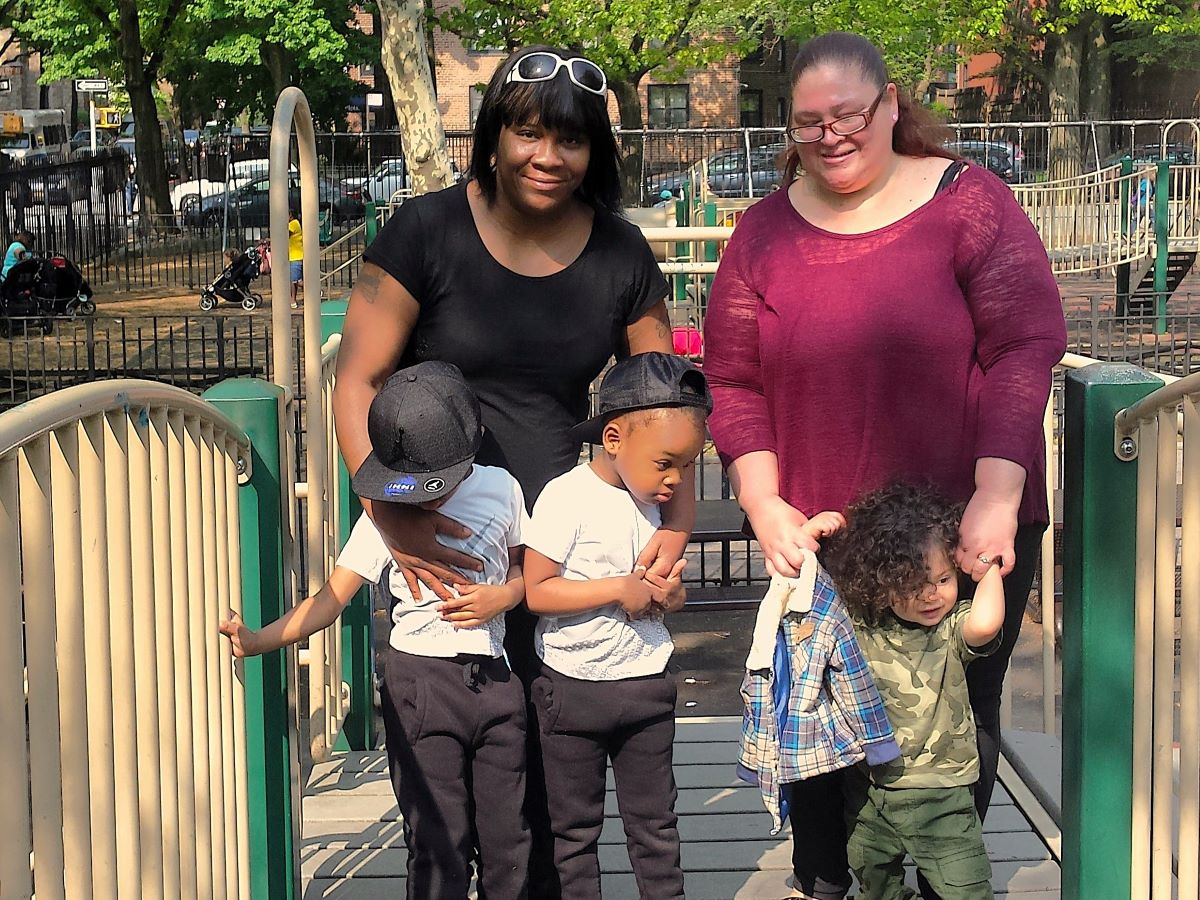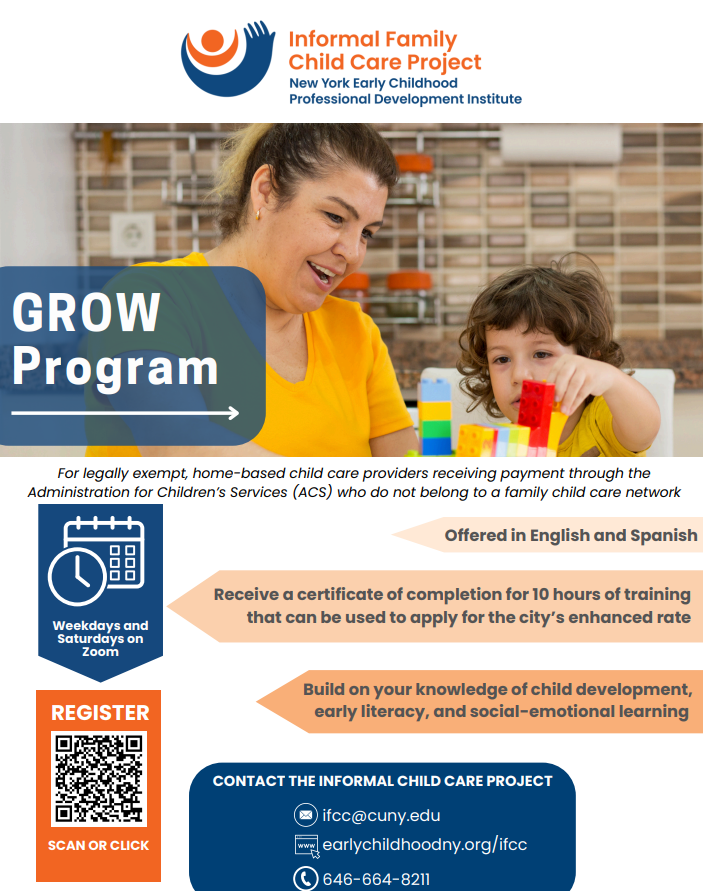Informal Family Child Care Project
Welcome to the Informal Family Child Care Project! We are proud to serve and support home-based family child care providers, who play a vital role in the lives of thousands of children and their families. Whether you are looking for professional development, resources, or guidance with home-based child care, we are here for you.
We believe that children learn best when their learning involves playful, joyous experiences that are rooted in strong, trusting relationships. Our workshops and trainings are created specifically with family childcare providers in mind, at no cost to providers, to build capacity and confidence.
We look forward to connecting with you!

Get in touch
We're here to help! Call our caring, knowledgeable and bilingual staff to register for our events, for referrals to services and resources and for help and guidance with home-based child care.
IFCC Information Line
Available Monday through Friday, 9 a.m. to 5 p.m.
Meet our team
To learn more about our team, please visit our staff page.
What we offer
IFCC Legally-Exempt Child Care Provider Training
PDF • 1.9MBTraining for legally exempt home-based child care providers receiving payment through the Administration for Children's Services (ACS) who do not belong to a family child care network.
IFCC Children with Differing Abilities Training
PDF • 664KBThe Informal Family Child Care Project is committed to helping child care providers improve their practice with children with Differing Abilities.
IFCC Resource Guide
PDF • 6.6MBIn this guide, you will find information about places to visit with children and tips for making your outings safe and engaging. The guide is organized in two ways – by borough and by type of experience or venue – and puts information about the diverse resources NYC has to offer at your fingertips.
Our latest TIPS and TOOLS
Practical advice and resources to support your work with young children in home-based care settings.
Let's Run and Walk!
What to do? Talk about what is happening as you and your child run fast, walk slowly, stomp like a dinosaur, or dart like a pigeon.
Why? Your child will learn words and develop skills in running and moving. This simple activity is a first step to forming an intentional plan about how to coordinate and control their body and actions.
For Preschoolers: Describe the move and make it like a "Follow the Leader" game. For School age children: Describe the move and have them do it. Create a word wall and write words like "fast, slow, forward, backward, etc."
Early Learning Guidelines
Want to learn more about child development? Here is a copy of the NY State's Early Learning Guidelines (ELG). Search the age group of the child in your care and see what they can do!
Learn moreMirror, Mirror
What to do...Give your child a safe, hand-held mirror. Have him or her look into the mirror and make faces and actions. Offer them a comb, toothbrush or washcloth. Ask them to practice smiling, brushing their hair, move their eyebrows, brush their teeth, wash their face, etc. As they are doing it describe his/her actions and facial qualities. For example: "Wow, your eyes go up when you smile or move your eyes".
Why is this important? This activity builds your child's social and emotional and language skills. The more your child learns about himself or herself and what he or she can do, the more comfortable he or she will feel in new situations.
For school age children: Give them a safe mirror and ask them to draw a self portrait as they look at themselves in the mirror. You draw your self-portrait as well and compare the two together!!!
Local Library Resources
Do you know where your library is located? Are you aware that they offer fabulous activities for children and adults? Check out this website, find your local library and the activities they are offering.
Learn moreWondering what caused it?
What to do? Get a clear bottle (i.e. a used water bottle). Add water in the bottle about halfway and add six drops of oil. You can also get two paints/markers (red and yellow), mix them to make a new color (orange). Encourage your child to be a detective in discovering what caused something to happen. Ask them to tell you "How did that happen?" Offer a different idea if the explanation is inaccurate. Do not correct the child's theory but simply offer another view. Encourage any effort to figure out the cause of the mystery.
School age children: After the activity, give him/her a piece of paper, a pencil and have them draw what they notice. Let them write what they think cause things to happen.
Why is this important? Exposing children to activities that promotes curiosity, and persistence helps them build their approach to learning and social and emotional intelligence. They explore cause and effect! Try it with water freezing, a broken toy or leaves falling from trees.
Go Noodle
Have you heard about Go Noodle? It is a fun, learning and teaching tool. Try this FREE resource to engage the child or children in your care to learn about personal and community wellness, mental and physical health, in ways that are fun, exploratory, and highlight their unique, natural self. Dance, rap, sing and mediate with your child/children. One of IFCC's favorite activity is called "MELTING". Search for it on the website.
Learn moreWhich Is Best?
What to do? Give children in your care simple and safe problems to solve. Offer the child choices when facing the problem. Ask them "which is best?" Some activities that can help with making choices are building a tall tower, playing board games, playing catch, playing JENGA and/or deciding which clothing to wear or snack to eat. For example: Build a tall tower with the child. Allow the tower to fall. Ask the child "do you think the tower needs a wider or shorter bottom?" Build the tower again and see what happens. Continue to encourage the child to come up with their own idea or give them choices.
For School-age children: use the same process for helping them make good decisions in school. For example: Give them choices for getting along with other children, setting time management skill for homework or projects.
Why is this important? Children need to know how to select the best solution to solving a problem. Weighing alternative paths of action is a key step in solving problems. Later children will use this skill independently to solve other problems successfully.
CAPS Online
Do you have questions about childcare payments? CAPS ONLINE can assist! They can be reached at 212 835-7610 or capsonline@earlychildhoodny.org. You can also go to the Childcare Payment Portal and view or download your paystubs.
Learn moreCollect and Describe
What to do? Go on a community walk or stroll around your home. Give the child in your care a baggie or bag and encourage your child to find small items that they feel are "treasures" or interesting on the walk. Ask him or her to collect the interesting items in the baggie. Find time to ask the child to display the items they collected and talk about them. Begin to ask the child questions about the item. For example: "What did you find interesting about this item?" If you are not sure what to ask remember to use your 5 "W"s...What?, Why?, When?, Where? Who?
For school age children, when you begin to look at your child's collection create a list of adjectives your child uses to describe the items or give them adjectives to use. For example, "big, small, shiny, rough, or bumpy" Afterwards, you can begin to sort or categorize them.
Why should you do this? This activity builds your child's personal choices and interests, which supports their decision-making process.
Developmental Milestones
Check out the CDC website for the Development Milestones and a milestone tracker. You can order one of each.
Learn moreShapes are all around us!
What to do? Shapes are all around us. Point & say: That window is a rectangle. Ask: "What shape are the wheels on the car?" Or "Can you find a circle, square, rectangle and triangle?"
School-age children: Look for shapes on the bridges. Show pictures of the Brooklyn Bridge, George Washington Bridge or a bridge near where you live. Play "I spy" naming the shape you see and see if they can find it.
Why should you do it? You can help build your child's math and language skills by pointing out shapes and asking questions about them.
CDA Information
Interested in receiving a CDA? Happy May! It is time for new beginnings! Are you interested in getting a CDA (Child Development Associates)? Attend CUNY School of Professional Studies CDA Information Sessions on May 8 at 7pm. Click to learn more information.
Learn moreLet's Count
What to do? As you put the dishes away, count the plates 1-by-1 with your child. Try it again with the bowls. Forks? Cups? Can your child count the cups by himself(herself)? You can help by counting items during everyday activities.
School-age children: Be creative! You can count the number of steps to the car, bus stop or to school. Incorporate addition, subtraction or multiplication.
Why should you do it? Counting is one of the first math skills that children learn. Keep counting. You're preparing your child with math literacy!
What do you want to know?
What to do? Encourage your child to be curious. Give children opportunities to ask questions.
Preschool children: Show them an item (ex: a toy, book, a picture, snack, etc.) and you start asking questions about it (ex: how does this toy work? Am I supposed to hold it or put it down)? Tell the child it's their turn? You can prompt them by asking "what do you want to know about ______?" You do not need to answer the question, but you can if you want to!
School age children: Give them scenarios (ex: A girl or boy doesn't want to go to the supermarket with her/his mother." Ask them to ask questions about the scenario. If they need help ask them "what do you want to know about this situation?" Write down their questions.
Why should you do it? Kids have lots of questions! Encouraging them to ask questions, encourages them to be curious. Curiosity guides learning. It also supports a child's ability to problem solve.
Sesame street in communities video featuring IFCC
Sesame Workshop invited IFCC to help create a training video about Friend, Family and Neighbor (FFN) caregivers as part of their Sesame Street in Communities (SSIC) initiative. Check out the video to learn more about FFN caregivers and our work.
What our community says
We are proud to share the positive feedback we have received from our community. Here are some testimonials from our child care providers who participated in our training and professional development programs.




